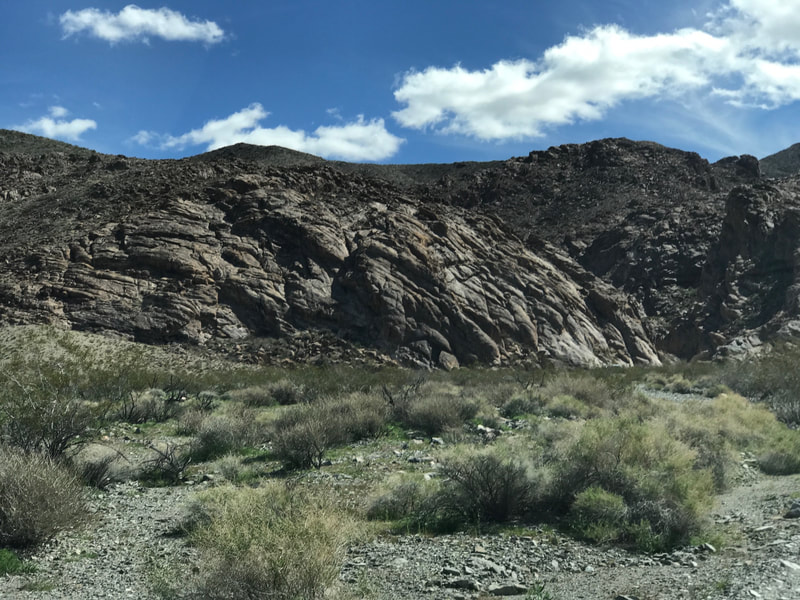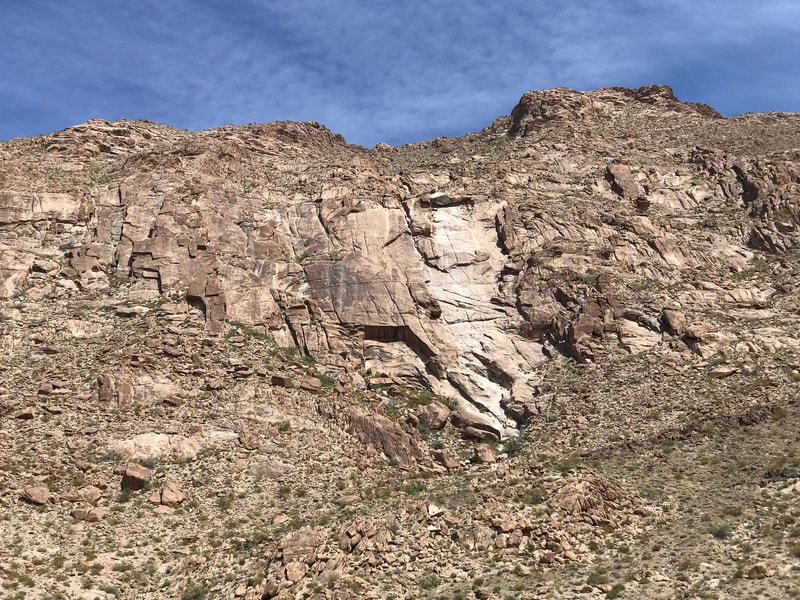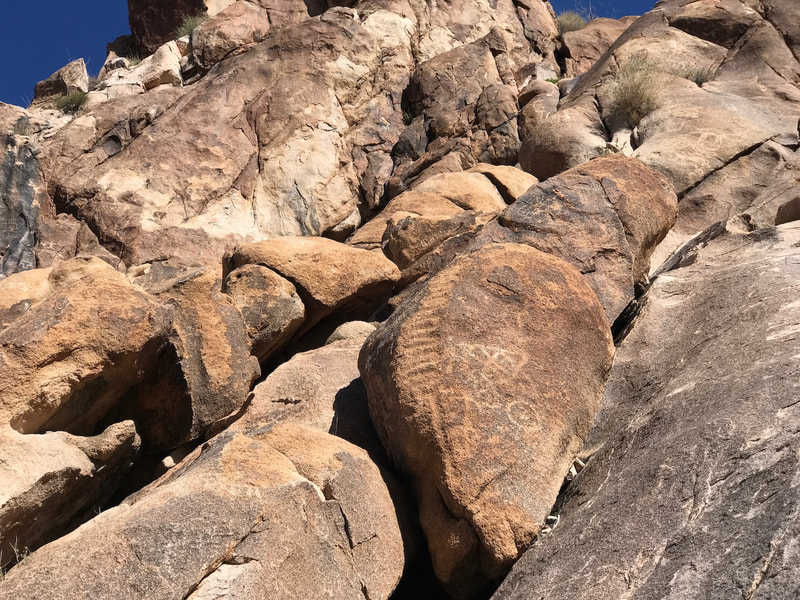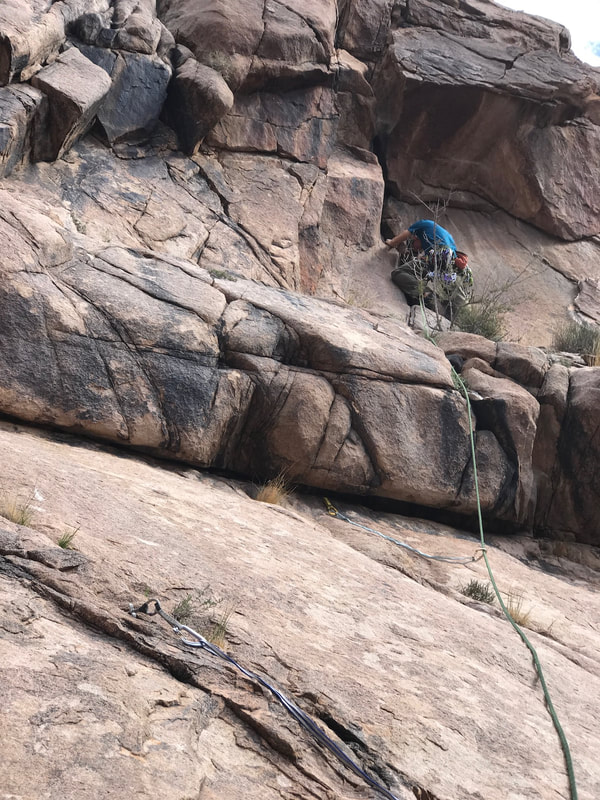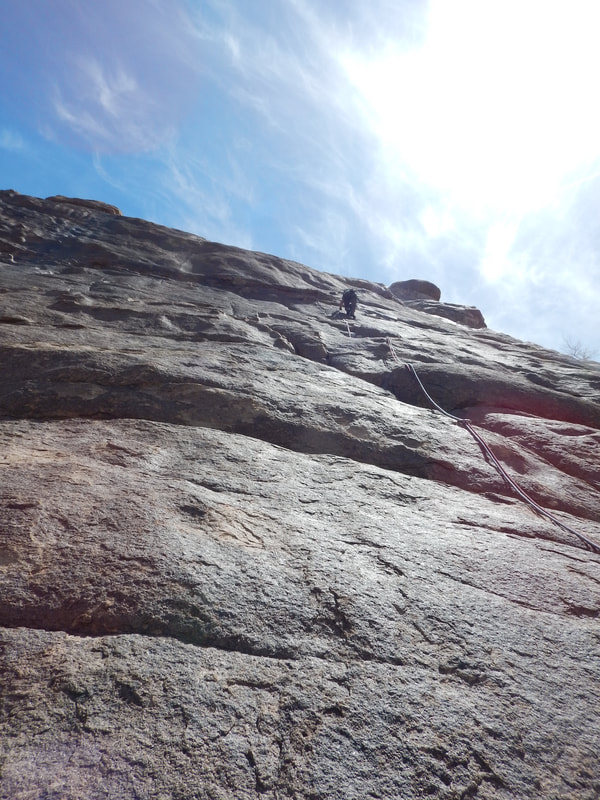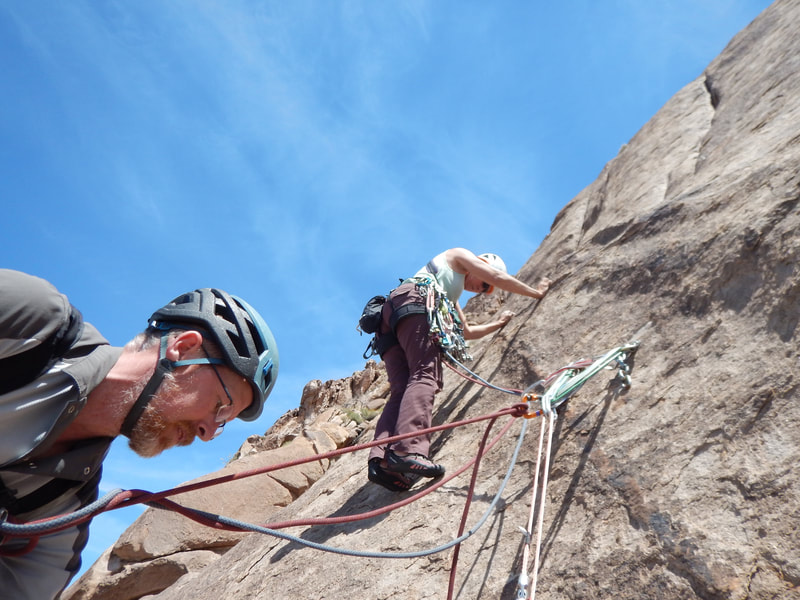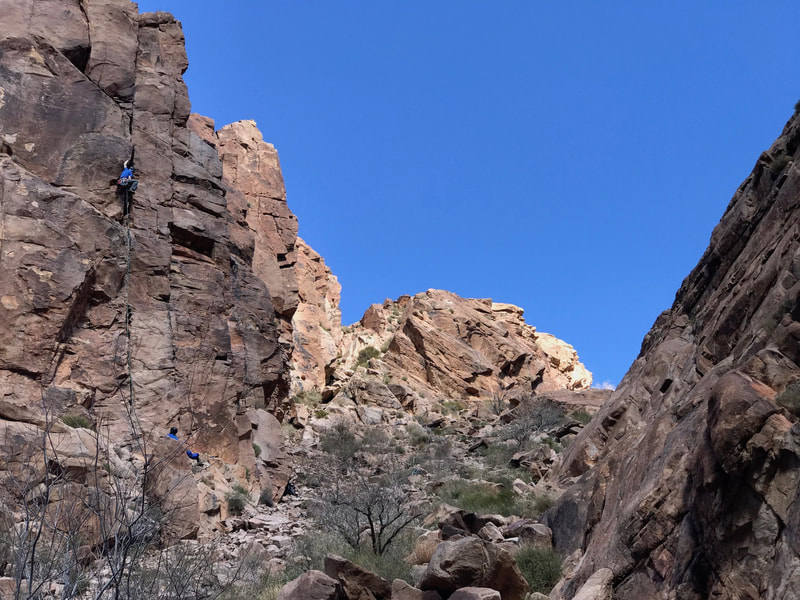The ground rules for climbing location "yeahs" and "neahs"
- Each location will receive an opinion rating - "It Rocks!", "Worth It," "Meh," or "Trash."
- Each crag has its own personality with unique advantages and challenges, which are highlighted.
- It is tempting to list “beautiful” as a “yeah,” but that is true for a lot of crags. I allude to beauty and scenery in the summary. You can also (sometimes) tell by the photo. If the place is a dump, then that will be listed in the “neahs” and rated as "Meh" or "Trash.
Summary
Keyhole Canyon is an old-school granite traditional climbing crag located about 45 miles south of Las Vegas, NV. There are also bouldering options, as well as top rope options (which require using trad gear/natural protection with long slings or static rope for the anchor.)
Keyhole Canyon is an entertaining rainy day (or post rain) option to Red Rock Canyon if you can’t climb the sandstone. It’s also a nice option for locals to get onto different rock, or those looking for a scruffy trad adventure. The approach for many of the climbs are short, but there are some with up to a ½ mile hike in. Beware of the drive in (see Directions section for more info).
This is a low desert environment and can get scorching hot in the summers. Fall, winter, and spring are the best times to climb. You can chase some shade or sun as needed.
There are some very beautiful Native American pictographs and petroglyphs here! Please respect this heritage and admire with your eyes and appreciate with your heart. Do NOT deface the rock, artwork, or add your own “signature” to the rock – even with something like charcoal or chalk.
There are also some hiking trails and a canyoneering route.
Directions
From the I-11 / US 95 interchange (under the bridge), go south on US 95 for 14.8 miles to a dirt road turnoff on the east side of the highway. ^1 (see notes below)
Cruise up this dirt/gravel road for 2 miles until you reach a "T" at the second set of power line towers. Go right / south
Head south for 2 miles on this slightly rougher road until you see a "main road" (e.g., not a tower pulloff) heading left towards the rock face and canyon entrance. If you're in a low clearance vehicle be especially careful on this last stretch.
^1 Notes - Finding this turnoff can be tricky. Here are some tips:
* The Nelson turnoff is at 8.8 miles from the interchange.
* The turnoff you want is Route S and is 14.8 miles from the interchange.
* If you are coming from Las Vegas, the I-11 off ramp will deposit you .2 miles south of the interchange.
* There are 4 left turning lanes on US 95 when going south from I-11: McCullough Pass / Solar farm, Nelson/Rd 163, El Dorado, and Route S (the one you want!)
* If you go south past Route S and take the next left (as Google maps will recommend), that is Route T. This road is far worse than Route S and absolutely requires a high clearance vehicle.
https://www.google.com/maps/dir/35.9520753,-114.9016621/35.7440306,-114.9554823/@35.7442439,-114.9549995,352m/data=!3m1!1e3!4m2!4m1!3e0
NOTE ON THE DIRT ROADS: We have successfully driven our Honda Fit in there several times, but we usually end up cringing, hitting some hidden rock, and saying we should’ve driven our other car that gets worse gas mileage but with better clearance.
Grading, Boltings, and Guidebook Tips
Most routes were established between the early 1960s to early 1990s and grading tends to follow the old school standards. Thus, grading can be variable depending on the year the climb was established and can tend towards being mildly sandbagged compared to today's modern climbs (although the climbs don't seem to be as sandbagged as other areas.)
Some climbs have a bolt or two to protect a desperate spot or super long runout, but this is a traditional area - bolts are few and runout is common place. Do NOT expect any sport climbs – even if it says so on Mountain Project. Attempts were made to create a few sport climbs and the bolts have been chopped. Bolts that were added to reduce run out on established climbs also get chopped. If you want to establish new climbs here, I recommend you contact Jimmy "Frodo" Lybarger first (see guidebook below for contact information). He knows the history and ethics of the area.
Although there are a few bolted anchors here and there – do NOT count on there being bolted anchors for a climb. Be prepared to build a trad anchor – including for top ropes – or to walk-off. Many climbs can easily be walked-off, which also makes it accessible for setting up top ropes. Having long slings and/or a shorter static rope to set up a toprope using trad gear and/or natural features is very helpful.
Guidebooks:
Rock Type, Climbing, and Style
The rock at Keyhole Canyon is granite. The rock in the main part of the canyon tends to be solid and well worn from frequent climbing, although some crumby stuff does exist. Climbs in the lower canyon are single pitch. Longer multipitch climbs are located on the White Dream Slab. Note the rock on the White Dream Slab can have a thin crumbly veneer and it can take some searching to find the “worn/solid” spots, but they are there.
The climbing style is varied with featured face, pure crack, and pure slab (and combinations there in). As mentioned above it is traditional old school with an occasional bolt here or there.
Camping
Primitive camping is available on the BLM land outside of the canyon. There are no toilets or facilities, so please pack out ALL of your trash, food waste, human and animal waste (yes your poop and toilet paper too!). The desert does NOT biodegrade these things well. Also fires do NOT burn glass, aluminum at all nor does it burn plastics well. Do NOT burn trash, pack it out in your car which will be sitting right next to you!
Do NOT burn fires inside of the canyon! I know it seems awesome and romantic to burn a fire in the canyon, but it leaves a nasty mess and the area is labeled as off limits for fires. Please use the existing fire rings outside of the fence.
Please, please, please give a damn. This place is awesome but could turn to shit fast by the careless.
Yeahs
Neahs
Opinion Rating
Worth it!
Keyhole Canyon is an old-school granite traditional climbing crag located about 45 miles south of Las Vegas, NV. There are also bouldering options, as well as top rope options (which require using trad gear/natural protection with long slings or static rope for the anchor.)
Keyhole Canyon is an entertaining rainy day (or post rain) option to Red Rock Canyon if you can’t climb the sandstone. It’s also a nice option for locals to get onto different rock, or those looking for a scruffy trad adventure. The approach for many of the climbs are short, but there are some with up to a ½ mile hike in. Beware of the drive in (see Directions section for more info).
This is a low desert environment and can get scorching hot in the summers. Fall, winter, and spring are the best times to climb. You can chase some shade or sun as needed.
There are some very beautiful Native American pictographs and petroglyphs here! Please respect this heritage and admire with your eyes and appreciate with your heart. Do NOT deface the rock, artwork, or add your own “signature” to the rock – even with something like charcoal or chalk.
There are also some hiking trails and a canyoneering route.
Directions
From the I-11 / US 95 interchange (under the bridge), go south on US 95 for 14.8 miles to a dirt road turnoff on the east side of the highway. ^1 (see notes below)
Cruise up this dirt/gravel road for 2 miles until you reach a "T" at the second set of power line towers. Go right / south
Head south for 2 miles on this slightly rougher road until you see a "main road" (e.g., not a tower pulloff) heading left towards the rock face and canyon entrance. If you're in a low clearance vehicle be especially careful on this last stretch.
^1 Notes - Finding this turnoff can be tricky. Here are some tips:
* The Nelson turnoff is at 8.8 miles from the interchange.
* The turnoff you want is Route S and is 14.8 miles from the interchange.
* If you are coming from Las Vegas, the I-11 off ramp will deposit you .2 miles south of the interchange.
* There are 4 left turning lanes on US 95 when going south from I-11: McCullough Pass / Solar farm, Nelson/Rd 163, El Dorado, and Route S (the one you want!)
* If you go south past Route S and take the next left (as Google maps will recommend), that is Route T. This road is far worse than Route S and absolutely requires a high clearance vehicle.
https://www.google.com/maps/dir/35.9520753,-114.9016621/35.7440306,-114.9554823/@35.7442439,-114.9549995,352m/data=!3m1!1e3!4m2!4m1!3e0
NOTE ON THE DIRT ROADS: We have successfully driven our Honda Fit in there several times, but we usually end up cringing, hitting some hidden rock, and saying we should’ve driven our other car that gets worse gas mileage but with better clearance.
Grading, Boltings, and Guidebook Tips
Most routes were established between the early 1960s to early 1990s and grading tends to follow the old school standards. Thus, grading can be variable depending on the year the climb was established and can tend towards being mildly sandbagged compared to today's modern climbs (although the climbs don't seem to be as sandbagged as other areas.)
Some climbs have a bolt or two to protect a desperate spot or super long runout, but this is a traditional area - bolts are few and runout is common place. Do NOT expect any sport climbs – even if it says so on Mountain Project. Attempts were made to create a few sport climbs and the bolts have been chopped. Bolts that were added to reduce run out on established climbs also get chopped. If you want to establish new climbs here, I recommend you contact Jimmy "Frodo" Lybarger first (see guidebook below for contact information). He knows the history and ethics of the area.
Although there are a few bolted anchors here and there – do NOT count on there being bolted anchors for a climb. Be prepared to build a trad anchor – including for top ropes – or to walk-off. Many climbs can easily be walked-off, which also makes it accessible for setting up top ropes. Having long slings and/or a shorter static rope to set up a toprope using trad gear and/or natural features is very helpful.
Guidebooks:
- Mountain Project: https://www.mountainproject.com/area/105941578/keyhole-canyon
- Keyhole Canyon of Southern Nevada: A Rock Climber’s Guidebook by James Lybarger. Jimmy (aka Frodo) has numerous first ascents in Keyhole Canyon and is part of a group of locals called “Team Keyhole.” Frodo has written a guidebook that can be obtained by calling or emailing: 702-401-4155, [email protected]
Rock Type, Climbing, and Style
The rock at Keyhole Canyon is granite. The rock in the main part of the canyon tends to be solid and well worn from frequent climbing, although some crumby stuff does exist. Climbs in the lower canyon are single pitch. Longer multipitch climbs are located on the White Dream Slab. Note the rock on the White Dream Slab can have a thin crumbly veneer and it can take some searching to find the “worn/solid” spots, but they are there.
The climbing style is varied with featured face, pure crack, and pure slab (and combinations there in). As mentioned above it is traditional old school with an occasional bolt here or there.
Camping
Primitive camping is available on the BLM land outside of the canyon. There are no toilets or facilities, so please pack out ALL of your trash, food waste, human and animal waste (yes your poop and toilet paper too!). The desert does NOT biodegrade these things well. Also fires do NOT burn glass, aluminum at all nor does it burn plastics well. Do NOT burn trash, pack it out in your car which will be sitting right next to you!
Do NOT burn fires inside of the canyon! I know it seems awesome and romantic to burn a fire in the canyon, but it leaves a nasty mess and the area is labeled as off limits for fires. Please use the existing fire rings outside of the fence.
Please, please, please give a damn. This place is awesome but could turn to shit fast by the careless.
Yeahs
- Good rainy day alternative to Red Rock (granite).
- The walking approach is short for most climbs.
- There are a fun variety of climbs and a spectrum of grades.
- There are vistas, a lovely canyon, and beautiful Native American pictographs and petroglyphs. It’s a small but special place.
Neahs
- The dirt road in lengthens the drive and isn’t that great for low clearance vehicles.
- Despite the drive in, it can get busy on weekends – especially if its been raining at Red Rock Canyon.
- Some routes have marginal rock.
- Be prepared for chopped bolts and run out on some climbs. It’s a bit unpredictable in this way.
Opinion Rating
- Keyhole Canyon is not really destination climbing but it still great climbing and good fun when you are a trad climber and prepared for its personality. It holds a special place in the heart of many locals.
Worth it!

